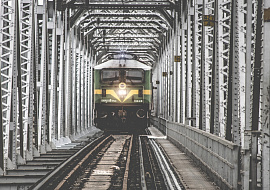Trouble-Free Deployment of Communications-Based Train Control
This advanced signaling system integrates interlocking, automatic train operation, and automatic protection to roll out a seamless, high-performance rail network. CBTC deployment demonstrates how efficiently leading rail providers are combating the challenges that the digital world imposes on the extensive “heritage” of railway networks worldwide.
We note quite often how easy it is to overlook misguided actions even before and during main project phases that postpone and prolong the commissioning phase. If facing the truth, over 80% of the rail lines under Communications-Based Train Control modernization do not meet projected terms for launching, which is yet accepted as a norm. However, it’s obviously not the goal to achieve.
Being a rail signaling, hardware, and software development company, PSA has explored CBTC inauguration from multiple sides to provide a comprehensive overview of hassle-free deployment practices.
Implementation Plan for Communication Based Train Control: From Phase 1 to Commissioning
When revolutionizing the rail network with CBTC, thorough planning is the foundation that guarantees 3/4 of the success in the commissioning phase. This process involves carefully assessing the network's needs, internal processes, and resources, selecting solution components, and creating a strategic deployment plan.
Assessing Network Requirements
When gearing up to implement Communications-Based Train Control, a hard look at the network's infrastructure is vital. CBTC network infrastructure will be spread out across many locations, including rail cars, maintenance vehicles, wayside equipment, yards, terminals, and stations. This calls for a scalable and resilient network that connects all these points throughout your rail system's geographic reach.
To enable safety-critical railway communication for today and future operations, the network must support:
-
High-speed train movement
-
End-to-end coverage of long track sections
-
Smooth data transfer without losses
-
Tightly controlled network latency < 500 ms
-
Wireless data transfer time < 50 milliseconds
-
Extremely low data packet loss < 0.1%
Given the rapid evolution of communication technologies, ultra-reliable, two-way wireless communication around all the signaling units promotes the solution to keep its relevance as long as possible.
Great Documentation Management
Documentation is the first and mostly the only thing that experts work with on your CBTC implementation project. Every LED, cable, and contact added or removed is essential to be recorded in the decades-long or even centennial history of the rail line. Thus, ensure no missing documents first, and second – its full reflection of the field situation.
By validating no inconsistencies between the Book of Plans and the field, you eliminate:
-
Unplanned activities in hardware design, communication, and deployment phases
-
Re-ordering, or under-ordering custom equipment
-
Time and budget waste
Particular attention should be paid to the rail sections and equipment that were recently modernized since documentation often misses the changes made. Likewise, ensure the documentation you develop now reflects all the updates to prepare the fertile ground for future modernizations. A skillful engineer detects signs of inconsistencies during the docs survey of each interlocking, which is easily verified by taking a look at them onsite.
Besides rigid requirements for docs, it’s crucial to build a hard process of timely mutual documentation provision. This is true for all the subcontractors, including signaling, communication, CAD, construction, and so on. This way every party ensures long-term planning and deadlines are met. Otherwise, expect ‘unexpected’ delays.
Comprehensive Approach to Solution Development
Communications-Based Train Control is constantly evolving and expanding its coverage, which makes it crucial to develop future-proof end-to-end strategies that consider all the CBTC-related components as a cohesive mechanism. The comprehensive deep-dive research on the equipment to use is what protects you against redesign activities that happen frequently on such scope-intensive projects.
Core functions such as positioning and train tracking, propulsion and braking control, routing and movement authority, interlocking, and regulation are taken as non-negotiable. Meanwhile, unique operations needs such as service build-up, diagnostics and maintenance, recovery from service-affecting faults, passenger information systems, and level crossing warnings should be investigated and implemented considering the overall CBTC landscape. For instance, it’s much more efficient to implement level-crossing monitoring solutions at the phase of equipment development, rather than modify it after.
Renovation of a Phased CBTC Deployment Strategy
CBTC is constantly evolving and expanding its coverage, which makes it crucial to develop future-proof end-to-end strategies that consider all the CBTC-related components as a cohesive mechanism. To minimize risks and ensure a smooth transition, opt for the following practices to help with phase deployment:
Deployment of the Communications-Based Train Control software to a small and easily manageable group first allows for saving millions on further troubleshooting and operational maintenance.
The testing approach where rail locations, interlocking logic, speed profiles, communication protocols, cab environment, landscape features, and many more are simulated allows to ‘catch’ up to 100% of the drawbacks and bottlenecks that usually emerge during field testing.
To reduce network load and mitigate deployment issues, consider throttling the software availability. Set a time window between availability and deadline for each phase.
By following these best practices, you'll be well-equipped to plan and execute a successful CBTC implementation that enhances your rail network's performance and reliability.
Communication Based Train Control: Technical Challenges
Tough technical hurdles are inevitable during the introduction of CBTC. Your task is to make these challenges foreseeable and easily manageable to exclude their impact on commissioning.
Managing Radio Frequency Interference
When setting up a Communications-Based Train Control system, radio frequency interference can be a real headache. A whole range of factors that can mess with wireless connectivity has to be considered, which involves a lack of direct visibility, electromagnetic and channel interference, spectrum overload, and physical limitations to install radio equipment.
And don't forget about the environmental factors. For instance, GPS – which many systems rely on – can't operate in tunnels. This means you might need to beef up your infrastructure to keep your CBTC operation running smoothly underground.
Obsolescence Management
It seems that railways are doomed to fight with legacy forever through the long signaling system lifecycle. That’s why it’s extremely important to define obsolescence management strategies before the launch of the upgraded rail line.
Three core aspects are worth attention to overcome compatibility barriers:
- Standby traditional signaling. When interfacing with outdated and modern systems through outdated protocols, engineering expertise becomes crucial for accurately simulating and updating systems. These upgrades frequently necessitate additional dedicated transmission modules for interfacing with legacy systems, which often complicates the overall setup.
- Outdated equipment components. PLCs, their components, and interfaces eventually turn into legacy products, leading to compatibility issues. The addition of new components to CBTC-involved equipment can cause these legacy elements to behave unpredictably, and they often can’t be simply replaced through market absence.
- Dispatching representation. CBTC introduction requires robust wayside–dispatch communication to facilitate real-time data transfer. Such multi-layered operations demand sustainable development and ongoing support to ensure compatibility, optimize processor usage, or resolve memory issues. Profound expertise in rail system development is essential to guarantee flawless end-to-end supervision.
Optimizing System Performance
Getting your CBTC system to perform at its best is a balancing act. When aiming to minimize tracking errors and energy consumption while ensuring safety, here's where it gets tricky:
-
Complex channel conditions and frequent handoffs can seriously impact your train-ground communication performance
-
You need to optimize both communication and control aspects simultaneously
-
Safety constraints on train control actions need to be factored into your optimization model
To tackle these challenges, you might want to consider using advanced techniques like Deep Reinforcement Learning. This approach can help you jointly optimize handoff decisions and train control policies based on stochastic channel characteristics and real-time train position information. Remember, while you're pushing for peak performance, safety can't take a backseat. Simulation results based on real field measurements show that CBTC systems often need to sacrifice some performance to ensure system safety. It's a trade-off you'll need to carefully manage.
Communication Based Train Control: Best Deployment Practices by Stages
For more than 20 years of active implementation, CBTC has shaped its best deployment practices that now can be evolved to achieve the best industry results.
Comprehensive Factory Acceptance Testing
When deploying a Communications-Based Train Control system, comprehensive Factory Acceptance Testing (FAT) helps catch potential issues before the equipment leaves the manufacturer's facility, saving time and money in the long run. Nearly all equipment shortcomings are identified during FAT and are typically resolved on the spot within a day. Documentation review, visual inspection, component and sub-assembly testing, functional and performance testing must be carried out with equal importance.
To make the most of your FAT, consider these best practices:
- Collaborate closely with the manufacturer to establish clear expectations and requirements
- Develop a comprehensive test plan outlining specific procedures and acceptance criteria
- Employ skilled designers and test personnel familiar with CBTC design and industry standards
- Maintain ultimate precise and comprehensive datasheets to enable manufacturing at any facilities
- Connect the developed equipment to a detailed simulation environment with conditional switches, circuits, and signals to eliminate failure in every signaling scenario
Onsite Integration Testing
Once your CBTC equipment passes FAT, it's time for the trial run onsite to ensure all components work together seamlessly in your specific railway environment. SAT entails identical actions but is conducted in a real-world setting – directly in the field. Often, this procedure is segmented into integration tests and inspections, particularly in intricate projects. Nonetheless, the objective remains unchanged – to evaluate the performance of the entire railway line with the newly installed equipment. To streamline this process, consider setting up a fully automated off-site testing facility. Such a facility can increase efficiency and cost-effectiveness, improve resilience throughout the project lifecycle, and conduct thorough off-line testing, including interface, integration, timetable, transition, stress, and fault testing.
The lack of a unified standard for interlocking functionality often leads to suboptimal performance in some rail signaling solutions, particularly when the system is already operational. To address this, we advocate for the inclusion of independent rail signaling designers from competing firms. These specialists bring invaluable experience and a fresh perspective to wayside design, ensuring no detail is overlooked. Moreover, their insights can reveal alternative, more efficient solutions. Ultimately, this collaborative approach allows us to adopt best practices and enhance overall system performance.
Gradual Cutover and Migration Strategies
A well-planned cutover strategy is essential to be developed a long time before the transition to Communications-Based Train Control. Commissioning preparation includes three main approaches to consider:
-
One-time switching works well for smaller lines up to 5 miles and carries higher risks if issues arise
-
Zone-by-zone cutover starting from the least-loaded section and moving to the most ones
-
Periodic migration that involves fallback leading to CBTC by implementing a temporary system before full CBTC deployment
Regardless of the strategy you choose, prepare for a radical shift in your organization, including new training methods, maintenance capabilities, and operational procedures. A clear cutover plan helps minimize disruptions for your operators and passengers, while test automation increases efficiency and consistency during the integration process.
Deployment of Communications-Based Train Control: Conclusions
Communications-Based Train Control introduces a new chapter in the history of the rail line and the city. In addition to the implementation itself, it requires enhanced service, maintenance, and supervision approaches to support CBTC functioning at the highest performance.
To wrap up, the journey to implement CBTC is complex but rewarding. It demands a deep understanding of network requirements, a careful selection of solutions, and a strategic approach to deployment. By tackling technical hurdles head-on and following comprehensive testing procedures, rail operators can harness the full potential of CBTC. This groundbreaking technology is set to shape the future of rail transportation, and PSA will be happy to assist in its implementation to improve performance and reliability for years to come.















